November 2023

“Recently, I came across an article in a Dunnville newspaper written by T. L. M. Tipton of Dunnville. It had earlier appeared in THE CANADIAN MAGAZINE OF JULY, 1893 and was titled “AT THE MOUTH OF THE GRAND”. I have retyped it here for you and have made every attempt to find contemporary photos of the places and events he describes. To that end I contacted Percy Miller, Heritage Services Officer at Canadian Research Knowledge Network (CRKN), which manages the repository (Canadiana) of this magazine. Percy was kind enough to supply me with a much better digital copy of the article where I was then able to copy a number of original photos from the article. To view a digital copy of the article, and the enhanced digital images, please consult the citations below.
It is a long read, so get out a large coffee or better yet a tall beer and sit yourself down for a long read!
AT THE MOUTH OF THE GRAND
by T. L. M. Tipton 1893

1828-1915
Let us idle away one of these long sunny summer days on the banks of a Canadian water-way whose picturesque charms are not to well known as hey should be. There is very little scenery in the Province of Ontario which can surpass in quiet rural beauty that found at many points on the Grand River, from its source away up beyond Elora, down to where it empties -a broad, deep, slow stream- into Lake Erie. We will linger for a while beside it, starting from Dunnville, and following its course down to its mouth at Port Maitland, a distance of about five miles.
The little town that we are leaving with its shaded streets, its villas and cottages surrounded by well-kept gardens, its quaint fishing suburb, its mills and its storehouse, is a place well worth something more than a passing glance. It can boast of waterworks, electric lights and natural gas. Many of the townspeople use this gas for fuel in preference to wood or coal. There are several wells in and near the town and they yield a fair supply.
The Grand River washes the little town upon its southern side, and a very long bridge and longer embankment cross the stream at this point. We will walk over them to the opposite shore.
This is the bridge; beneath our feet is the dam; beyond it the embankment.
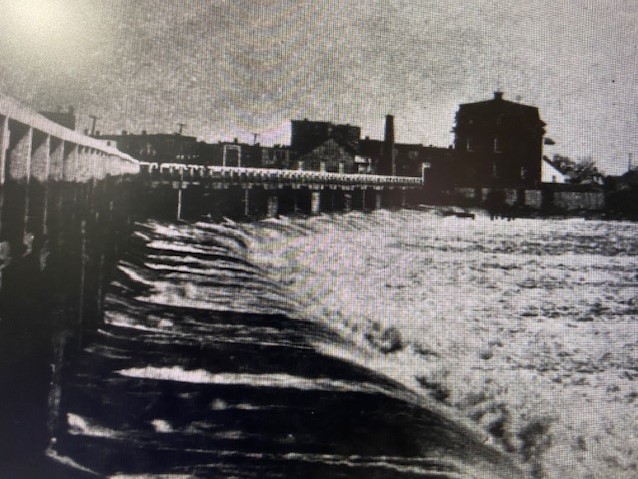
Long Bridge and Dam facing Dunnville Original photo from Article

Current Post card of Dunnville Dam Wm. Warnick collection
These works were constructed, when the present century was young, for the purpose of turning the waters of the river through a feeder into the Welland Canal. That canal drew its whole supply of water from this river until it was lowered to Lake Erie level a few years ago, since which time it has been fed from the lake.
Stand on this bridge for a few minutes and look away down the stream below you. It can be seen for more than a mile, flowing through the wide marshes and low grounds on either side of it. Then a sharp bend and a point of higher land hide it from our view.
How gloriously the waters sparkle in the morning sunlight! How intensely white seems the sail of that boat, heading up stream for Dunnville! She is probably bringing a cargo of fresh fish home from the lake to be sent by railway to Buffalo.
Today these waters are calm and peaceful as a standing pool, but in spring and fall they sometimes go rushing over the dam with a mighty roar, bubbling and boiling down below there, till the river for some distance is one sheet of foam.
We have passed the bridge now and are on the embankment-that very, very long barrier which reaches across to the opposite shore. On the upper side it is protected by wall of timber and a bank of stones; on the lower by a row of willows, whose roots twine in among the clay and gravel which compose it, and help to resist the action of the waters.
Away below us lies the marsh, a “level wash,” extending from the foot of the embankment to the mouth of Sulphur Creek, which flows into the river about a mile and a half away.
Fair and beautiful does it appear in the soft light of this summer morning. The cattle are wandering over it, cropping the fresh, juicy grass. A few of them are gathered in a picturesque group, close to those low-hanging willows by the water’s edge. Some of them stand out dark and distinct against the sun, while others are half hidden by the bushy trees.
I admit that it is a great flat piece of reeds, and flags, and wild grass, a slushy mixture of land and water, with no tree for the eye to rest on, except those few scraggy willows, and two small elms. But do not say that it lacks the charm of variety. Look at the thousand different lines which the light of early day sheds over it. See how the dark, rich green of the reed’s contrasts with the lighter shades of the grass, and with the gleaming waters of the channels which cross it here and there and connect the river with the creek.

The Grand River above the Dam Original photo from Article
Bright and pleasant as it seems, there are times when it presents a very different appearance. In spring, freshets have swollen the stream across the entire flats, and, far down as the eye can reach, is one vast sheet of rushing surging water. Nothing else is to be seen except the tops of the low trees peeping above the flood; not a speck of dry land is visible.
To properly understand and appreciate the beauties of the marsh, you should visit it at every season. You should look on it in the golden autumn, when the waving reeds have changed their green dress for one of deep russet brown, when vast flocks of blackbirds go forth from it at morning in search of food, and return at evening to their nests. See! There are a few of them there now, flitting about and perching on the tallest stalks they can find. They build their nest and hatch their young down in the solitude of this wild marsh, and leave it for a warmer climate when the cold weather approaches.
In the fall of the year this place is a favorite resort for ducks, too. Then you may hear the guns of the hunters in every nook and corner of it, and see men popping in and out among the tall reeds in their little tiny skiffs, which look as if a puff of wind would blow them over. You should come here then, and in winter also, when in the severer spells it is one great field of ice and snow, with brown tufts of withered grasses and flags dotting it here and there. I think that it is more truly picturesque then than at any other season.
A few weeks earlier than now in June would have seen the sturgeon fleet on the lower river just below the bridge-a sight worth seeing. To behold the fishermen in their rude punts bobbing up and down on the stream of foaming water which leaps over the dam, and throwing out their baited hooks to entice the big fish, is an experience worth having. It becomes fairly exciting when they catch hold of one of these monsters of the deep, and after a fierce struggle, drag him puffing and blowing, into the boat.
Sometimes they remain out hours after sunset; then the long streak of white foam resting on the dark and gloomy river, and the almost ghostly appearance of the fisher-boats, as they dance on it for an instant and then vanish into the shadows, form a phantom-like scene such as Rembrandt or Salvator Rosa would have loved to paint.
Now turn round and look away up stream! What a noble piece of water it is- a small lake, in fact, over half a mile in width as far as we can see it, and that is over three miles. The river, in its natural state, was not half as wide, but the building of the dam and embankment had the effect of overflowing the flats for some miles up, and thousands of acres, which were formerly covered with tall, spreading trees, have been for many years under water. At some point the dead trunks and branches of these trees still remain standing. They remind us of those weird pictures of barren and blasted forest, which we meet with in the writings of some of the old romancers and poets. But, for the most part, wind and storm and decay have done their work with these giants of the wood, and nothing but the stumps can now be seen.
It is good to rest here for awhile, taking no heed of the flight of time. Calm, clear and bright the beautiful river lies before us, not a wave, not a ripple, to break the repose of its surface. Like some vast mirror, it reflects every object on its banks -the trees, the white mills and storehouses, the dwellings, the barns, the bridges- we see them all down in those mystic depths, plain and distinct both in form and color.
“How came the long double row of broken piles there?” you ask, – “there on the further side of the stream, which seems to run up past that inlet?”
This is all that remains of the old original tow-path. Long before steamboats or locomotives were known in these parts, great teams of horses used to toil along it, dragging scows and barges and schooners behind them. For many years the Grand River was the principal outlet for the whole surrounding country. Immense rafts of oak and pine and elm were then brought down it, to go by way of the Welland Canal and the St. Lawrence to Quebec -for the forest of this region were once rich in timber. One of these rafts, with its shanties built on it, and its crew of French lumbermen, was a sight to gladden the eyes. How the merry fellows would run round on it, lively as crickets, singing one of their native songs, as they labored with their pike-poles to push it along.
After the introduction of steamboats, the light traffic between these parts and Buffalo was carried on, for the greater part, by a few side-wheelers, built so as to navigate shallow waters.
There are many in this neighborhood who can well remember when the old Experiment and Dover used to come in here by way of Port Maitland and the feeder, laden with cargoes of freight and passengers from Uncle Sam’s dominions. Then they would steam on up the river as far as Brantford, escaping the rapids by means of locks and short canals. Almost any evening during the season of navigation one might stand on this embankment and see steamers com puffing down each with her tow of loaded scows and schooners behind her.
All this is over now; the Grand River is a deserted highway; the locks and dams in the upper section have been carried away by the floods, or suffered to rot down, and it would be difficult for anything much larger than a rowboat to pass Cayuga-seldom, indeed, does a lake craft of any kind go even that far. The grain is carried chiefly by the railways, and the trade in gypsum seems to have ceased. The forest, too, have been stripped of their best timber, and nothing is ever rafted down here, except a few small saw logs and poles.
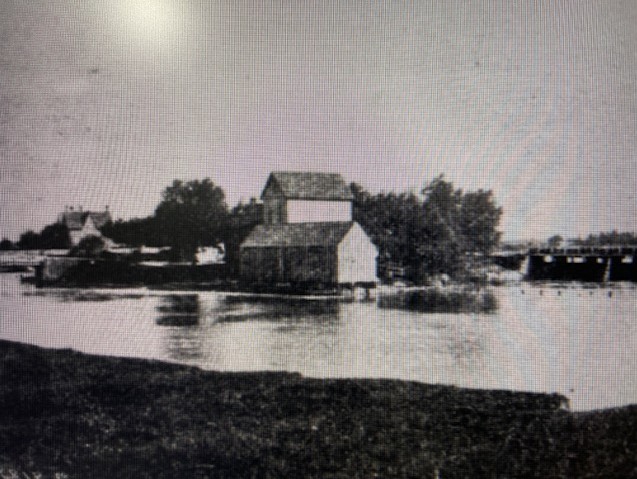
Mill and Waste Weir on Sulphur Creek Original photo from Article
But, though the palmy days of the noble stream may be ended, time has not robbed it of its picturesque beauty: it has increased, rather than diminished it. Like some old veteran, whose battles are over and whose bustling days are past, it has now that quiet charm which repose and decay along can give. The merchants and the mariners, who once trafficked on its waters, have abandoned it to seek employment and wealth amid busier scenes. But though they have deserted it, it still has its lovers and admirers. The artist now delights to haunt its banks and transfer some of its numberless bits of enchanting scenery to his canvas or his paper. This neighborhood is fast becoming a favorite resort for landscape painters. Some member of the Buffalo Sketch Club spent the greater part of last summer here, and many of the pictures exhibited at their annual opening were taken by them between Dunnville and Port Maitland. This summer they are here again, busily sketching.
You shake your head and look grave. I know what your thoughts are. Yes, Hawthorne did say that when a country or region becomes an object of interest to painters and poets, it may be safely considered to be in the last stages of decay. I admit the truth of the observation; it will hold good as far as the river is concerned; but if you were to see the little town over there on a market day, when the streets are crowded with wagons loaded with farmers’ produce, you would not think that it was in any danger of going down. A good farming country lies all around. Heavy grain crops are grown in the townships west of the river and now that the low, sandy lands of Moulton are well drained, they produce roots and fruits in great abundance.
The fine prospect on both sides makes this embankment a most enjoyable place for a stroll. On summer evenings, especially on Sundays, after church, half of the population of Dunnville may be seen here. But there are times when nobody will venture to cross it unless compelled. When the late fall winds are blowing a hurricane down the river, the waves will dash against it and break over it in showers of spray that would drench one to the skin in a few minutes. At the time of the great flood in 1869, the waters burst through and made a gap of over 200 feet long. Then the lower stories of half the houses in Dunnville were flooded, and the people rowed about the streets in boats for several days. The low, flat pare of Moulton township were also overflowed for several miles back from the river. These overwhelming floods are now things of the past. The village fathers of Dunnville have raised the road along the river so as to form a level breakwater, and an additional waste-weir has been built. The embankment, too, has been made higher and stronger.
We pass thriving-looking homesteads, rich pastures and fields of winter wheat, which promise fair for a good yield at harvest, should nothing happen to blight or injure them.
The land on this side of the river is comparatively high, but on the marshes skirt the lagoon-like stream down to its mouth, and stretch away south and east to the banks of the feeder.
At last, we come to where the sand hills block the way, and the road branches off. Let us mount the steep bank, although it is rather hard climbing, for the sand is so loose that our feet sink into it at every step. From the summit of these mounds, we have a delightful view. The lake, the piers, the light-house, the long line of sandhills, sweeping round the crescent bay down to Mohawk Point, burst at once upon our sight. Far as the eye can reach, the great inland sea lies before us, clear and peaceful. The spirit of repose seems to have shed its influence over it, and to have lulled it into slumber as deep and as sweet as the sleep of a child. Away out we catch sight of the white sails of vessels, and the smoke of a steamboat. Here all is quiet; there is nothing to disturb the pervading tranquillity; not a sound is to be heard save the murmur of the waters as they ripple on the sand.
Here, at the end of the embankment, is the first of the three great wash-weirs which carry off the surplus water and are the safeguards when there is danger of being flooded. A pleasant, airy, picturesque spot it is. On the upper side is the wide river and look across it and you will get a fine view of the front street of Dunnville, with the tops of the higher buildings and the towers of the churches. On the lower side, the swift current sweeps round into Sulphur Creek, and when the valves of the weir are open and the water is rushing through them, it becomes so rapid and strong that it would be rather difficult to stem it. When, like the “sweet Afton,” it flows gently along, the lake fish delight to come up and play here. On each side of the channel, you may see one of the quaint-looking dip-nets used in this region, with its long balance pole and its upright rest. It hangs over the water ready for a dip whenever indications are favorable. On the opposite side, close by the tall white grist mill, a couple of fishermen are sitting down enjoying a smoke under the thick willows that overhang the little mill-race. In a few minutes they will probably let down the net and make a catch. The fish caught here are most of them, find eating, especially the bass, both black and white. These fishermen are professionals, who pay the Government for their licenses and follow the occupation for profit. They own seines as well as dip-nets, and if you come at the right time, you may see them putting off in their scow-built punts and then throwing out their nets and dragging them to shore heavy, perhaps, with every kind of fish that is to be found in these waters-pike, pickerel, bass, sucker, mullet, and, it may be maskinonge – the finest and delicious of all, so epicures say. At certain seasons of the year it is unlawful to catch some of these fish. Should one of the prohibited happen to get into the net at these times, the fishermen, of course, make a point of throwing it back into the water, more especially if the inspector should chance to be looking on.
In addition to the professionals, there are a number of amateurs who love to frequent the waste-weirs and other points where the fish congregate. They are mostly old gentlemen, retired tradesmen, officials, and farmers, who are spending the evenings of life in Dunnville, and who, in these long, hot summer days, find their chief recreation and employment in the sport which Isaac Walton so loved. These gentlemen use nothing but the hook and line, and these they can ply to their heart’s content without let or hindrance.
The summer months, July and August especially, generally bring a number of visitors to enjoy the sport of trawling. Boats and guides are always to be hired, and on may see them starting off up stream and down with spoon-hook and line and lunch-basket, if he chances to be aboard in the early morning hours.
It is time that we were on our way to Port Maitland. The little islands and the old canal, just above we stand, are worth devoting a few hours to, especially when the inlets are covered with beautiful white pond lilies which seem to float on the surface of the water. They make a fine contrast with the dark green leaves that surround them.
You can glance at the second waste-weir as we cross the Sulphur Creek bridge. Like the first it is a solid substantial stone structure, built at great expense on a firm foundation of piles and puddled clay.
Leaving the quiet village of Byng, we take the river road, and are soon on the summit of a little hill from which we get another fine view of Dunnville. As we look across the marsh, the town seems to lie on the very edge of it. From this point the eye can also take in the long bridge and embankment, the lower river, and the creek with its branches dividing the green expanse into fairy-looking islands, while the beams of the morning sun falling upon the scene, give it the charm of life and freshness.
A mile or two more and we are past the great bend and in sight of the sand dunes of Port Maitland-high mounds which look in the distance like a chain of tiny mountains. They shut out the lake from our view, but the tall masts of a schooner lying in the harbor can be plainly seen towering above them.

Sand Dunes at Port Maitland Wm. Warnick collection
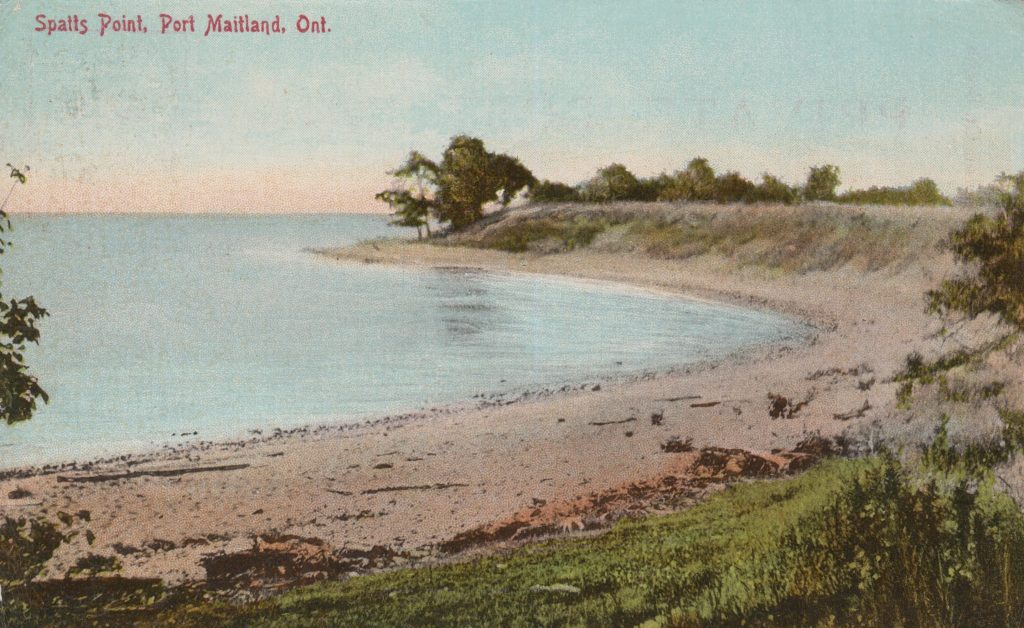
Sand Dunes Lakeside, at Port Maitland Wm. Warnick collection
Our surrounding “breathe immortality” and invite us to meditation. While we are in this mood, it will be good for us to linger for a while in the little churchyard, which lies yonder, just at the upper end of this chain of hillocks or dunes. You can see the tower of the church through the trees. A wild, solitary spot it is, lying amid the sands, with the vast lake in front of it, and an atmosphere of mingled sadness and sweetness pervading it. The grass has grown high and rank in places, bramble has cropped up, the sand has drifted in and buried portions of the fence, and of some of the gravestones, but there is a charm in this secluded God’s acre, which the more pretentious cemeteries of great cities do not often possess. The spirit of the place awakens tender feelings, and inclines us to deep and solemn thought. There is nothing to break the spell which it casts over heart and mind. No crowd of sightseers, no elegant equipages sweeping by, no gay flower-gardens and inappropriate decorations to turn our attention from things that are afar off to the pomps and vanities of the world.
The little wooden church is Anglican, and is old as age is reckoned in this country. Some of these tombstones have been standing for more than half a century. As you walk round, and read and ponder, you will observe that a number of old officers lie buried here. The lake shore for several miles west of us was originally settled by military and naval officers from England, who came out here to form a little colony, and live the free independent, pleasant life of country gentlemen. Some of them laid out much of their means in improving their farms and in building substantial dwellings for themselves, but the found, generally, that farming in Canada was anything but profitable in those times except for practical, hard-working men, able and willing to endure privation and rough fare. As most of them had regular incomes, they managed to live comfortably, but their descendants, with a few exceptions, have left the neighborhood to seek more congenial employment in our towns and cities.
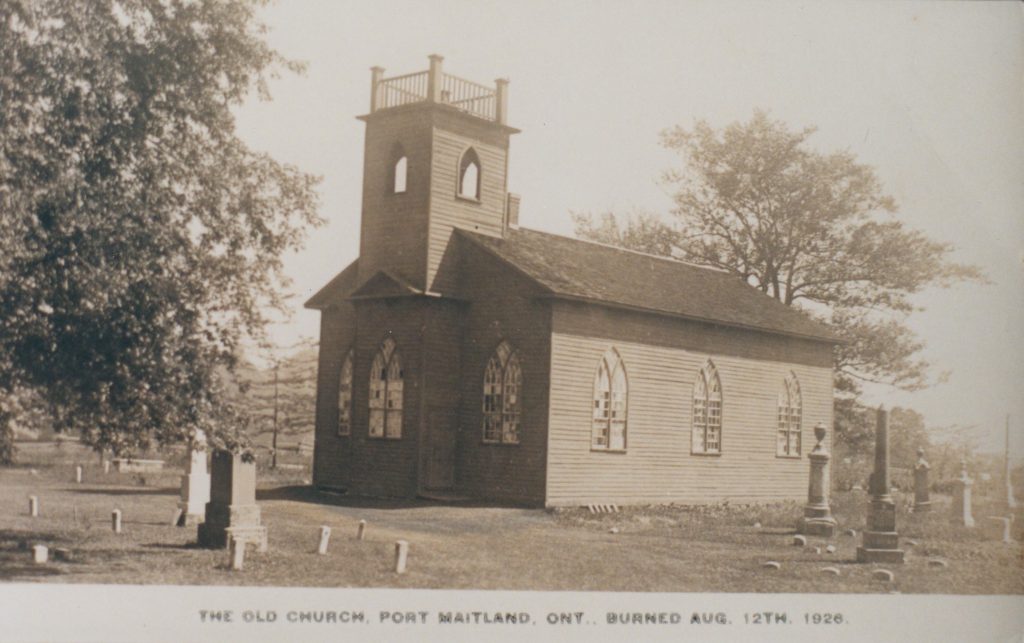
Wm. Warnick collection
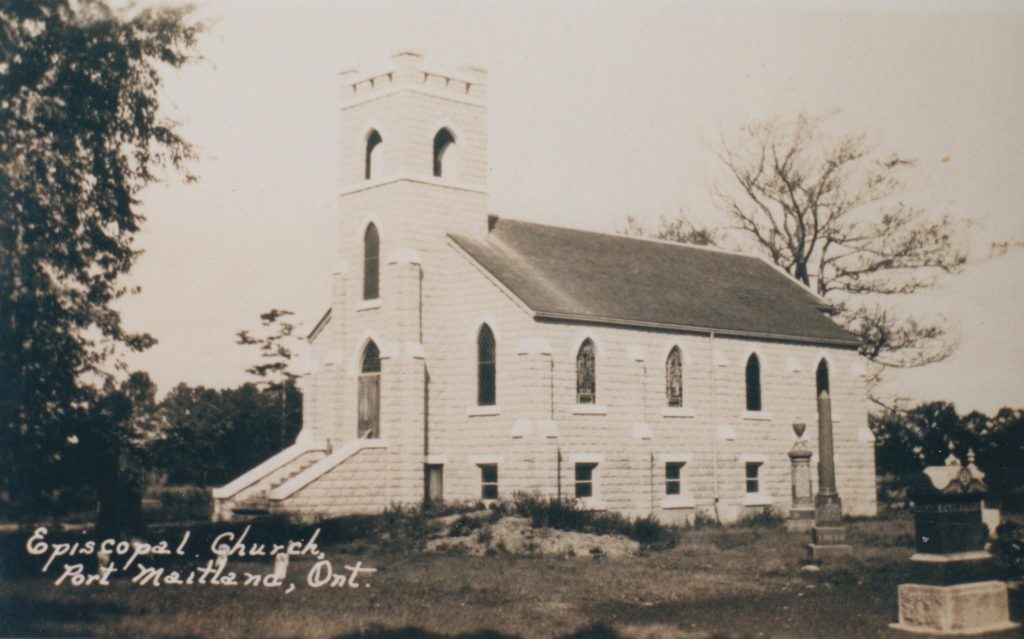
Original burnt Aug. 12, 1926 Wm. Warnick Collection
You wonder why the grave we are approaching is made of such extraordinary length, -as if it were that of a giant. Beneath that mound of earth rest the remains of a band of gallant soldiers, who belong to the famous Twenty-Third, or Welsh Fusiliers, and who were drowned near this shore in 1850. They were on their way from Montreal to London, and were going by steamboat as far as Port Stanley. Their vessel was run into by another and sunk a little way out from this place. Assistant Surgeon Grantham, some non-commissioned officers, and more than forty men perished, and their remains were interred in this churchyard, as may be seen by the inscriptions on the headstones. The accident happened in the night, and it is said that one of the vessels did not have her lights properly displayed. But that as it may, the poor fellows went down and “They laid them by the pleasant shore, And in the hearing of the wave.” [Note the total who died was 39 men women and children. It is believed that only 24 caskets were purchase by Christ Church, leaving some uncertainty as to how many bodies were buried in Christ Church Cemetery.]
There have been many shipwrecks in this bay, when the storms of autumn raged, and the lake vessels were making the last trips of the season.
How invitingly cool seems the Lake in these sultry days! No wonder so many Dunnvillites have built summer cottages on its shores.
We will walk along the beach to the village. We can see the tops of the house over the sand-hills.
You would like to know something about the origin of these sand-hills. Well, I confess I cannot tell you how they came here; I am not in the least scientific. Probably they were blown up by the winds and are the work of the gales of centuries. I think that they go on increasing in size from year to year, as fresh sand is washed up from the lake.
This must be a scorching hot place when the summer sun is pouring down his rays on it, especially when there is no breeze off the lake, for there is very little shade here; nothing appears to grow on these dunes, except a few scrubby, stunted hemlocks, which creep long the ground and look like vines rather than trees. But notwithstanding this, there is a peculiar fascination about the scene. The glare and heat of the sands at noon-day make the cool lake look still more welcome and refreshing, and when the evening yellow falls upon them, they seem actually to take on the long lines of golden light and the deep-hued masses of shadow.
Artists always love low sandy shores like this. Some of the most attractive pictures in our galleries are taken from just such scenes. This neighborhood has received its share of attention. Mr. George Merritt Clarke, a talented member of the Buffalo Sketch Club, was here for several weeks last summer, sketching among these sands and the old tumble-down house of the village which is now in the days of its decline, but not, I trust of its fall.

Original photo from Article
The good people of Port Maitland, some of them at least, wondered what attraction the place could have for an artist and could not understand how the picture of an old frame building not worth five dollars could fetch almost as many hundreds, when put for sale.
Here is the mouth of the river, and the capacious harbor, one of the very largest and best on Lake Erie. A fleet could ride at anchor in safety under those piers. Away across, on the other shore of the river is the lake entrance to the Feeder. The lock is about a quarter of a mile up it.
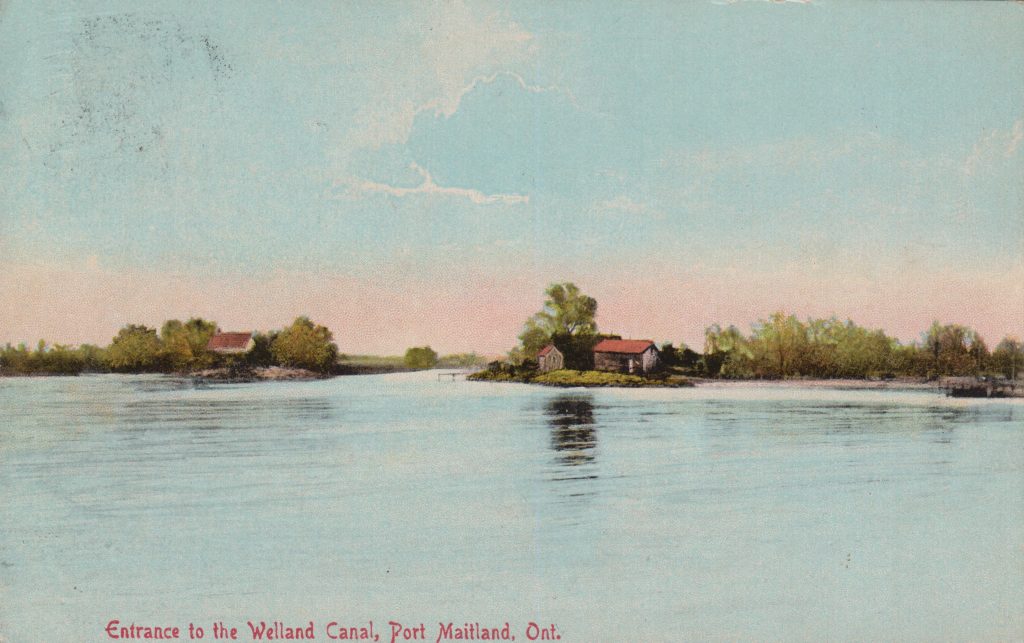
Wm. Warnick collection
Round about us lie the house of the Port, and, if decay and dinginess are signs of the picturesque, this place must surely be an Artist’s Paradise, for more dilapidated-looking affairs than some of these old structures are, could scarcely be seen anywhere. The light-keeper’s house and the neat hotel are modern respectable and prosaic, but the rest of the buildings are antique, unpresentable, and dear to poet and the painter’s heart.
See, that worn-out frame cottage. It stands there on the sand-bank, but every house in Port Maitland rest on a similar foundation. It is a village build on sand.
During the war of 1812, and for many years after, Port Maitland was a naval station, perhaps the most important on the lake. Some of the old inhabitants here, can remember H.M.S. Minos, and her commander Lieutenant Hatch. She was stationed here away back in the forties, and was withdrawn when Great Britian and the United States withdrew all war-vessels from the lakes. [ NOTE The Grand River Naval Depot which was the stations’ name was not established until 1815 following the War of 1812 as a buffer from the Americans continued desire to occupy more of what would become Canada. It was called The Grand River Naval Depot as Port Maitland was not named until 1828.]

Painting by Peter Rindlisbacher
The Port was a busy place formerly but its trade, like that of the Grand River, has fallen off.
Steamers here took in their supply of firewood, and great piles of it were to be seen on the docks. The harbor was filled with vessels all summer long, steamboats wooding up, schooners which had put in for supplies or for shelter, little fleets of Grand River scows and barges waiting till the lake was calm enough for the tugs to tow them across to Buffalo. Great rafts of timber often lay here for days. During the time of the American civil war, a good deal of round pine was brought in to go through the canal, immense sticks, some of them over one hundred feet in length and three of four in diameter. At that time the Southern ports were blockaded and ship yards had to get their masts and spars from Northern forests. The only industry which seems now to flourish in the place is fishing; this is carried on to a considerable extent. The great reels for nets which are seen on the sands in front of some of the houses show what is the occupation of the inhabitants. Some of these fishermen ply their trade along the beach with seines; others have gill nets in the lake. Any one who stays here for a few weeks will have an opportunity of seeing their little steamboat come in at early morning with its cargo of fish, and go out at evening when they set their nets. If one is fond of fishing either with hook or trawling line, he can find no better place for a summer outing: there is the river to sport on and near by is the cool lake. Accommodation is easily obtained; no more comfortable and pleasant country tavern can be found than the cheerful-looking little in with its good table, airy rooms, and aspect of neatness, so that a stay by the spot where the broad, slow river melts into the breezy bosom of Lake Erie, lacks not in the comforts of life found in other summer resorts.
Citations
Article:
“At the Mouth of the Grand.” The Canadian Magazine, no.5, vol. 1, 1892, pp.347-355.
Canadiana, https://www.canadiana.ca/view/oocihm.8_06251_5/19.
Images:
“At the Mouth of the Grand.” The Canadian Magazine, no.5, vol. 1, 1892, pp.347-355.
Internet Archive, https://archive.org/details/sim_canadian-magazine_1893-07_1_5/page/354/mode/2up. “

T.L.M is very descriptive in his writing. Taking the reader from his present backward in time. The funny thing is, the present moment that he is talking about and experiencing in the article is now the past. Which is now an entirely new present that he probably could not have imagined.
I enjoyed taking a walk with him, learning about an area that he knew so well and one that I do not… I feel as though I had joined my 3x great grandfather on on his walk…as if I were walking alongside him.